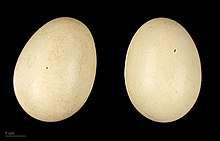Silver teal
The silver teal or versicolor teal (Spatula versicolor) is a species of dabbling duck in the genus Spatula. It breeds in South America.
| Silver teal | |
|---|---|
-_Macho.jpg) | |
| A male in Brazil | |
| Scientific classification | |
| Kingdom: | Animalia |
| Phylum: | Chordata |
| Class: | Aves |
| Order: | Anseriformes |
| Family: | Anatidae |
| Genus: | Spatula |
| Species: | S. versicolor |
| Binomial name | |
| Spatula versicolor (Vieillot, 1816) | |
| Subspecies | |
| |
| Synonyms | |
|
Anas versicolor Vieillot, 1816 | |

Between April and June they prefer reed beds and will lay 6 to 10 creamy-pink eggs. As with swans and geese, both parents will rear the ducklings.[2] A pair may bond long term. It lives on fresh water in small groups, and feeds primarily on vegetable matter such as seeds and aquatic plants.[3][4]
The silver teal's range includes southern Bolivia, southern Brazil, Paraguay, Argentina, Chile, Uruguay, South Georgia, South Sandwich Islands,[1] and the Falkland Islands.[5] The southernmost birds migrate to southern Brazil in the winter.
Silver teals are on the whole placid ducks but may be protective of eggs, young and females.[2]
Description
They have a black cap that extends below the eyes, and a bluish bill with a yellow tip. They also have a green speculum with a white border.[6]
The Puna teal was previously regarded as a subspecies of this bird. Currently, there are two subspecies:
Footnotes
- BirdLife International (2012). "Spatula versicolor". IUCN Red List of Threatened Species. 2012. Retrieved 26 November 2013.CS1 maint: ref=harv (link)
- McKinney, Frank; Brewer, Gwen (1989-01-01). "Parental Attendance and Brood Care in Four Argentine Dabbling Ducks". The Condor. 91 (1): 131–138. doi:10.2307/1368156. JSTOR 1368156.
- "Silver Teals | Beauty of Birds". www.beautyofbirds.com. Retrieved 2019-04-11.
- "Anas versicolor Vieillot 1816 - Encyclopedia of Life". eol.org. Retrieved 2019-02-23.
- Clements, J. (2007)
- ArthurGrosset.com
References
- Clements, James, (2007) The Clements Checklist of the Birds of the World, Cornell University Press, Ithaca
- "Dabbling Ducks". Connecticut Waterfowl Trust. April 2, 2003 (Retrieved October 31, 2006).
- Falklands.net
